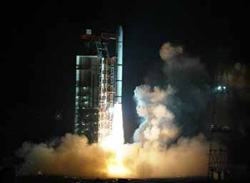
The first of two scientific satellites known as Double Star was blasted off into orbit on the early morning of Dec. 30 from the Xichang Satellite Launch Center in southwest China.
At around 3 o'clock on December 30, 2003, as the first of the two satellites involved in "Double Star" project, "Probe No.1" was successfully launched into its preset orbit by a Long March 2C/SM carrier rocket at Xichang Satellite Launch Center in Sichuan Province of China, hence marking the success of a key stage of the project.
The design and manufacture of the platform and the assembly of the satellite were carried out by the Chinese Academy of Space Technology with the China Aerospace Technology Corporation, and its probing equipment were developed by the CAS Center for Space Science and Applied Research (CSSAR) and eight European scientific research institutions.
Following an orbit with an apogee more than twice as high as that of the geosynchronous orbit, the equatorial orbiting Probe No. 1 monitors an important area of the magnetic field of the Earth that no satellites has ever covered. As the project goes on, another satellite of the Double Star, the Probe No. 2 to be launched in 2004, will explore another virgin area as a polar orbiting detector.
"Double Star" is an ambitious program proposed by CAS Member Liu Zhenxing and his team at CSSAR in 1997 and is jointly run by China National Space Administration and European Space Agency (ESA). By joining hands with the "Cluster II" system organized by ESA, it aims at establishing a 3-D observation system to simultaneously explore the ever-changing magnetic field around the Earth, so as to provide data for researches on the incidence and development of magnetosphere space storms, a kind of potentially disastrous space weather occurs in the planetary space between the Sun and the Earth.







